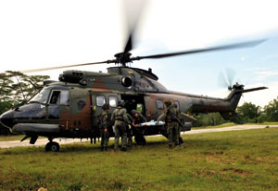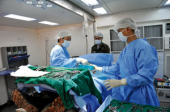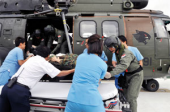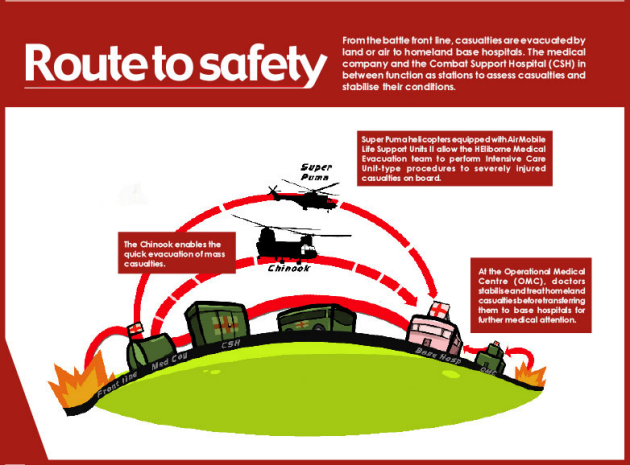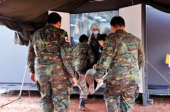OPS & TRAINING
SAVING OUR SOLDIERS
08 May 2009
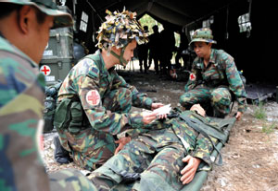
In battle, every man fights for his life. But behind the scenes, a dedicated group of people fight for the lives of others.
In a joint exercise conducted by the Singapore Armed Forces and the Ministry of Health, PIONEER takes you on the route of casualty evacuation from the heat of the battle into a zone where proper medical care is available.
Blood transports oxygen from the lungs to the rest of the body. Should there be an interruption to this flow, the resultant lack of oxygen can be life-threatening.
Like blood flow, any interference or delay in evacuating casualties can translate to a loss of life. To minimise such instances, the Singapore Armed Forces (SAF) Medical Corps joined forces with personnel from the Ministry of Health (MOH) in an exercise on 11 Mar to test the planning, coordinating and executing of casualty evacuation and management during operations.
Since 1990, this exercise has been carried out every three to five years. It also puts into practice the sharing of information among the different units of the Medical Corps and the MOH in the transportation of casualties.
Treading new ground
Other than evacuating front line casualties to homeland base hospitals, this year's exercise featured the new concept of an Operational Medical Centre (OMC) to tend to homeland casualties. In peacetime, the OMC is an SAF medical centre mainly helmed by Full-time National Servicemen (NSFs).
Captain (CPT) (Dr) Yap Hsiang, the Medical Officer-in-Charge at the OMC, explained that Operationally Ready National Servicemen (NSmen) Medical Officers (MOs) from a medical company staff the OMC together with NSFs during operations, with more doctors and medical equipment.
"This allows us to treat a greater number and volume of casualties at a greater speed during operational scenarios," he said.
Care at every step
During the exercise, casualties were evacuated from a simulated battle front line back to the participating base hospitals: Tan Tock Seng Hospital and Alexandra Hospital. In between, casualties were assessed at a medical company and a Combat Support Hospital (CSH) to ensure that they were kept in a stable condition.
Located near the front line, the medical company was the first stop for casualties. There, the injured were assessed on the severity of their injuries and those who required surgery were evacuated by land or air back to the base hospitals or the CSH.
With about 50 medics equipped to perform simple procedures such as wound dressing and resuscitation, the medical company can manage an estimated 600 military casualties in a day.
Commenting on the role of the medical company, Major (MAJ) (Dr) (NS) Chong Chin Kwang, the Officer Commanding (OC) of the medical company, said: "The medical company is quite a distance from the CSH. So at the medical company, casualties are stabilised before they are evacuated to the CSH or base hospitals."
At the base hospitals, a Hospital Military Casualty Administration Team (HOMCAT) monitored the status of military casualties.
"Basically, what we do here is...track the movement of all our servicemen who are hospitalised here," said MAJ (NS) Christopher Tay, Head, HOMCAT.
Hospitals without walls
Singapore's world-class health-care facilities are not only available in homeland hospitals; they can be found in the air and out in the field.
Super Puma helicopters equipped with Air Mobile Life Support Units II (AMLSU IIs) allow the HEliborne Medical Evacuation (HEME) team to monitor casualties and perform Intensive Care Unit-type procedures while on board the aircraft.
The CSH's rugged set-up of tents and containers in the field may give it a rudimentary appearance, but it is actually able to function like a homeland hospital. Procedures to sustain life and preserve limbs can be performed at the CSH as it is equipped with an operating theatre, a laboratory, a blood bank and about 50 doctors.
"The CSH is very well-stocked with the newest equipment, and we're able to perform full operations that require general anaesthesia, such as abdominal and chest operations," said MAJ (Dr) (NS) Lim Jit Kheng, a surgeon and Second-in-Command of Bravo Company, 2nd CSH.
Getting up to speed
With the CSH manned mostly by NSmen, having to familiarise themselves with the procedures at the CSH within their two-week In-Camp Training (ICT) was a challenge. Thankfully, the CSH has experienced NSmen surgeons, such as MAJ (Dr) (NS) Lim, to guide the newer surgeons and medics.
"We re constantly upgrading our skills and constantly imparting our experiences to the surgeons who are very good surgeons in normal civilian life, but need to adapt to the military style of operations," he said.
For 2nd Sergeant (2SG) (NS) Amir Hamzah, a Physical Education teacher at Victoria School, learning new procedures and the use of new medical equipment during his ICT was daunting for someone not in the medical profession.
However, the senior medic at the CSH who is grateful for the training provided during his ICT said: "ICT keeps us updated on new equipment and training methodology, and we have Medical Officers who are very forthcoming and who help us out in understanding the procedures and treatment."
Close cooperation
As participants raced against time to evacuate casualties, speed was of the essence in this exercise.
CPT (Dr) Bryan Ang, an Operations Officer with the Joint Medical Operations Branch of Headquarters Medical Corps who was part of the Exercise Planning and Control team, said: "One of the biggest challenges is really to keep the military casualty alive and stable all the way from the site of injury to the base hospitals, where they are able to receive further medical and surgical care."
By extending medical capabilities to all stations between the injury site and base hospitals and by improving coordination among the stations, the casualties' chances of survival are greatly increased. This necessitates a close working relationship among all personnel.
With the base hospitals playing a major role at the end of the evacuation chain, the SAF and MOH personnel had to overcome unfamiliarity with each other and maintain smooth communication.
This they did with both agencies updating each other on new developments and having table-top exercises to iron out all procedures before the actual exercise.
For MOH personnel, their participation in the exercise was to test the operational readiness of the hospitals and to see how fast they could react to emergencies.
"The exercise was a good opportunity for people on the ground to meet and iron out operating procedures together," said Mr Wong Yoong Cheong, Co-director of the exercise, and Director of the Operations Readiness Control Division at the MOH. Lieutenant Colonel Leo Sam Peng, Senior Medical Staff Officer, HQ Medical Corps, was the other Co-director.
Sharing similar sentiments, CPT (Dr) Ang said: "Through the exercise, we managed to establish an effective system of communication and information transfer between the SAF Medical Corps and the Ministry of Health."
A chance to learn
Other than the opportunity to work with personnel from different units and agencies, the exercise was also a great learning opportunity.
CPT (Dr) Yap, who was participating in the exercise for the first time, said: "It taught me the importance of saving casualties fast, and being decisive and swift in the management of the casualties."
Added another first-time participant, MAJ (Dr) (NS) Mark Tang, the OC of Bravo Company, 2nd CSH: "This exercise gave us the confidence that we can carry through a full evacuation all the way from the front right back to the base."
CPT (Dr) Ang summed up the achievements of the exercise: "What this does for the soldier in the SAF is to really give him the confidence that we are able to provide advanced and effective medical support should the need arise."
ALSO READ IN OPS & TRAINING

Exercise Wallaby 2025: To see better, shoot faster
31 Oct 2025
The SAF focuses on complex strike missions and multi-domain integration in Exercise Wallaby 2025, the 35th edition of its largest unilateral overseas exercise.

Ex Wallaby 25 – Greater Integration and Complexity
25 Oct 2025
The 35th edition of the SAF’s largest unilateral overseas exercise is an opportunity for expanded scale and deeper integration towards an effective, networked fighting force.

Ex Forging Sabre ramps up use of unmanned assets in integrated strike operations
12 Sep 2025
In this 10th edition of Exercise Forging Sabre, the SAF sharpened its cutting edge for the dynamic modern battlefield, with expanded integration between manned and unmanned platforms.


